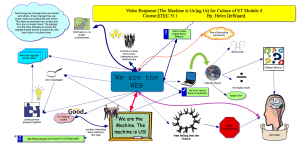This week’s module is the Psychology of Educational Technology. We have delved into readings by Sherry Turkle, Bonnie Nardi, and Dall’Alba & Barnacle. The discussions revolved around embodied knowledge, Cartesian models, human-technology relations and cyber-identity. We have been challenged to create a response to the articles and discussions through video (xTranormal.com) or Wordle.
We have been asked to write a paragraph expressing an experience related to the topic of Embodied Knowing in Online Environments. Here are my thoughts, relating to key passages that captured my attention.
“The primary way that things are encountered, according to Heidegger, is as instruments or obstructions to our projects and goals, rather than as objects of theoretical analysis (which Descartes’ deduction assumed).” (Dall’Alba & Barnacle, 2005, p. 733)
Merleau-Ponty states that all knowledge is embodied and it’s created in the unity between subjects and objects that is the direct result of having a body.
(accessed on Nov. 1, 2010 from http://www.thegreenfuse.org/harris/notions-of-ek.htm)
Sherry Turkle makes reference to an initiative she has instituted called ‘Objects Seminar’ where people present an object that has caused them to think differently about ‘self, other, intention, desire, emotion, the body.’ She states that ‘objects carry ideas, memories, ways of thinking about the world, ways of framing arguments.’
(p.2 in Open DOOR interview accessed on Oct. 27, 2010 from http://alumweb.mit.edu/opendoor/200307/turkle.shtml
All of these ideas link to work that Parker Palmer does with educators in his Courage to Teach work where he uses what is called a ‘third thing’.
An Excerpt from A Hidden Wholeness: The Journey Toward an Undivided Life by Parker Palmer
“We achieve intentionality in a circle of trust by focusing on an important topic. We achieve indirection by exploring that topic metaphorically, via a poem, a story, a piece of music, or a work of art that embodies it. I call these embodiments ‘third things’ because they represent neither the voice of the facilitator nor the voice of a participant. They have voices of their own, voices that tell the truth about a topic but, in the manner of metaphors, tell it on the slant. Mediated by a third thing, truth can emerge from, and return to, our awareness at whatever pace and depth we are able to handle — sometimes inwardly in silence, sometimes aloud in community — giving the shy soul the protective cover it needs.
“Rightly used, a third thing functions a bit like the old Rorschach inkblot test, evoking from us whatever the soul wants us to attend to. Mediated by a good metaphor, the soul is more likely than usual to have something to say. But the fact will count for nothing if we fail to recognize that the soul is speaking or fail to pay attention to what it says.”
Accessed on Nov. 3, 2010 from
http://www.spiritualityandpractice.com/books/excerpts.php?id=14443
The Lost Mind of Dr. Brain and Courage to Serve
Each of these great thinkers presents a notion of embodied knowing in relation to objects. The object that comes to mind through all these readings this week, for this module and for my upcoming essay, is the computer program developed by Sierra Software in 1995 called “The Lost Mind of Dr. Brain”. It was developed from the learning theory of multiple intelligence from Howard Gardner. I used this software as a element of my teaching while working in the computer lab of my school during the mid 1990’s. The premise of the game is to put back together the mind of the professor through various activities that relate to ‘ways of knowing’. Students would eagerly take on the challenges that best matched their strengths and quickly collaborated with peers who were better able to complete puzzles that were difficult or challenging for them. Students were not directly involved in the metacognition of the activity but indirectly learned a lot about how brains work and think.
To bring this together to the idea of ‘third thing’ and ’embodied knowing’ is the visceral reaction of my daughter when I mentioned the name of this software. A few days ago we were talking and this came up in conversation. Her reaction was immediate and animated. (My own children were frequently used as a testing ground for my educational ideas so she was subjected to Dr. Brain at an early stage.) Turkle talks about ‘getting them to talk about an object in their lives that might be deemed “evocative”, that had special meaning for them.’ This is what happened when I mentioned Dr. Brain to my daughter.
My reaction to this notion of embodied knowledge and ‘third thing’ comes from my self reflective work done through the two year retreat program offered through Courage to Serve-Canada. This work frequently brought out of me, through use of objects, articles, poetry, or conversation with others, a clarity or clearing of thinking, feeling or relationship. It was a unique experience that continues to help me merge ‘soul to role‘. There are many objects that embody my knowing. Objects that are evocative and carry meaning are embedded in memory and ways of thinking. I am better able to think about them and myself by knowing about embodied knowledge phenomenology.
